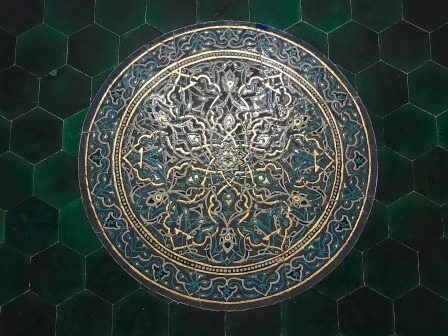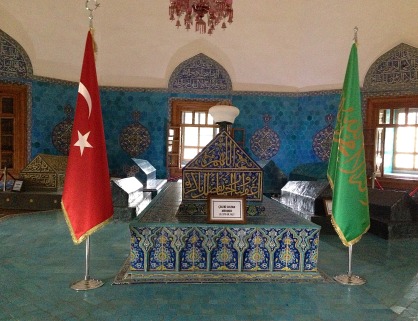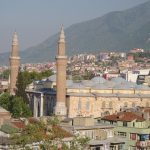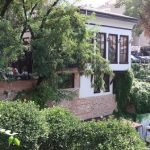Probably the single best known sight of Bursa is the so-called Green Tomb (Yeşil Türbesi) that stands in the district called Yeşil (Green), immediately to the northeast of the town centre. The tomb has become the main symbol of the city, far overshadowing in fame the nearby mosque with which it is linked.
Around Yeşil
If you’re walking to Yeşil from the town centre via Setbaşı you will come first to what was once the medrese of this particular mosque complex, built in 1419 for Sultan Mehmet Çelebi. The medrese now serves as a small and not especially impressive Museum of Turkish and Islamic Arts (closed Mondays), worth visiting mainly for the chance to inspect the building with pretty blue tiles above all the outside windows, and the cells and dershane (lecture theatre) of the seminary arranged around a pleasant courtyard with a fountain in the middle.
The museum is mere steps from the lovely tomb in which Sultan Mehmet Çelebi (1390-1421) was buried. It’s approached up a flight of steps which offer a fine frame for its blue-tile-clad exterior (apparently in old Turkish yeşil/yaşıl meant blue as much as green, hence the seemingly unlikely name for a building that is far bluer than the famous Blue Mosque). Inside, the sultan’s tomb could hardly have a more lovely setting, with the newly repainted mihrab the focal point of an octagonal room whose lower walls are lined with tiles and where each window is topped with a calligraphic inscription in blue and white tiling.
The tomb is so lovely that it’s easy to to overlook the mosque at the foot of the steps with its entrance on the far side facing away from it. Here the facade has been splendidly cased in marble with a soaring portal leading into a mosque designed along the inverted T shape popularised by early Ottoman architects. Stepping inside you will find yourself in the bar part of the T facing a pretty fountain containing a marble bird-house made in 2024 to replace the original stolen in 2004. On either side of the T are spaces that could be used for a variety of purposes, some of them enclosed and lined with pleasingly carved niches. Steps lead up to the prayer area which is in effect on a platform.
Before leaving, take a quick look at the şadırvan (ablutions fountain) outside which has a basket of marble lilies carved as its unusual centrepiece.
The long, low brick imaret (soup kitchen) of the complex survives beside the mosque, and what looks much like any other of the restored Ottoman houses nearby is labelled to suggest that it may once have been the hamam.
Transport info
Yeşil is easily reached on foot via Yeşil Caddesi which runs north from Setbaşi and is clearly signposted.
Nearby areas
Bursa: Emirsultan
Bursa: Yıldırım



